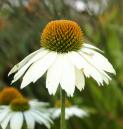Eugenia Jambolana Lam. (Syzygium Jambolana Lam.) Jambul. Jambol. Rose Apple. Java Plum.—This is a large tree belonging to the Myrtaceae, growing in East India and also in Queensland; well known on account of its popular edible fruit. The bark and seeds are employed in medicine. Jambul bark is a dense, hard bark, about 1.5 cm. in thickness, of a pinkish-brown or reddish-brown color, with a whitish-gray mottled cork or thick bark, the inner surface is of a somewhat silky luster, frequently coarsely marked by waving lines or ridges; the fresh fracture varies from pinkish or purplish to fawn color, sometimes distinctly but shortly fibrous, more commonly absolutely abrupt. The taste is somewhat bitter, astringent, after a time distinctly pungent. The bark contains a resin, tannin, and gallic acid. Jambul seeds are grayish-black or blackish-gray, being abruptly truncated at the base, above rounded or dome-shaped. They are from 1 to 2.5 cm. long, and 8 to 12 mm. broad; so hard and dense that they cannot be chewed, and are almost tasteless. The analysis of the seeds by Thomas Christy yields the following results. Essential oil, a trace; chlorophyll and fat, 0.37; resin soluble in alcohol and ether, 0.30; gallic acid, 1.65; albumen, 1.25; colored extractive soluble in water, 2.70; moisture, 10.00: insoluble resin, 83.73. Power and Callan (P. J., 1913, 245) found in these seeds a phenolic substance, jambulol, C16H3O4(OH)5, which is identical with ellagic acid.
In the experiments made by Thomas Christy of London (P. J., 1888), it was found that when sufficient of diastasic matter was mixed with fifty grains of starch to convert 45 per cent. of the latter in fifty minutes into sugar, the addition of twenty-five grains of powdered jambul seeds reduced the conversion of the starch to 12 per cent. We have no knowledge of the effect of jambul or its active properties upon the general organization, but Binz (Verhandl. der Kongr. fur Innere Med., Wiesbaden, 1886) found that when dogs were made diabetic by the administration of phlorizin, according to the method of von Mering, the exhibition of jambul reduced the excretion of sugar from 50 to 90 per cent. without the production of any evidences of poisoning by the jambul. In India, jambul has long been used as a stomachic astringent and carminative in diarrhea, and also in the treatment of diabetes. The first therapeutic trials in Europe appear to have been made by Clacius, who found that the drug notably reduced the excretion of sugar in diabetic patients. The practice has been largely followed, and there would seem to be no doubt that in occasional cases of glycosuria jambul does good. No cases of poisoning or of disagreeable results from it have been reported.
Nevertheless jambul has failed to establish itself as a practical medicament. It may be that this has been due to the use of too small doses. The dose of the fluidextract usually recommended is ten minims (0.6 mil); but according to von Noorden (Deutsche Praxis, 1901) half a fluidounce (15 mils) of the fluidextract should be taken in eight fluidounces (240 mils) of hot water, one hour before breakfast and late in the evening.
Jamrosin is a proprietary preparation asserted to be the fluidextract of jambul. It is alleged to possess marked remedial qualities in the treatment of diabetes.

